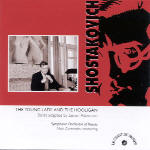First things first: Shostakovich never wrote a ballet called The Young Lady and the Hooligan. Rather, the score was cobbled together from existing works by Shostakovich’s trusted arranger Levon Atovmian–with the composer’s consent. To outline the story briefly: roughneck boy falls for schoolteacher girl; girl is taunted by boy’s gang; boy rushes to defend her and is killed by now-former friends. A careful listener will hear excerpts from The Gadfly and the Cello Sonata, along with selections less well known in the West (including the ballets Bolt and The Limpid Stream). Atovmian actually did a number of such projects with Shostakovich’s music, so a level of mutual artistic understanding already had been established between the two.
That said, it’s very difficult to categorize this work within Shostakovich’s canon, as there’s not much sense in judging the quality of a musical narrative that never really existed as such; it’s more of a footnote in the composer’s profile. Rather, the interest lies in individual moments and movements. There are some lushly beautiful, deeply lyrical and Romantic outpourings that we don’t often associate with Shostakovich, including the brief movements marked Vision, Scène, and Adagio (which features some gorgeous solo cello playing by Nazar Djourine). However, the brash, spiky Shostakovich comes to life, appropriately enough, in The Hooligan, The Cabaret, and The Brawl episodes.
Given the somewhat choppy nature of his raw materials, Mark Gorenstein does an admirable job of making the disparate hang together. The sound in this 1994 recording from the Mosfilm studios in Moscow is rather distant and one-dimensionally blunt. That’s too bad, since one of Gorenstein’s specialties is letting the bright elements–like the two-minute Hooligan movement, with its sliding trombone and punchy percussion–really sparkle.
































